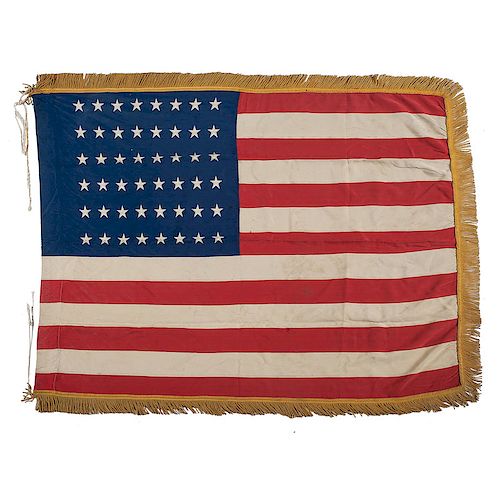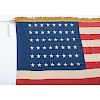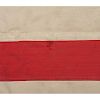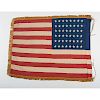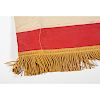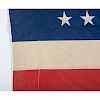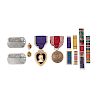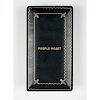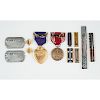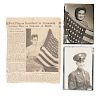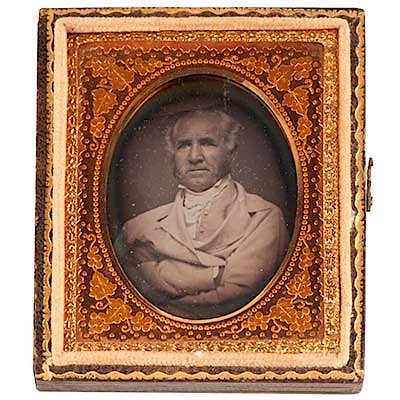48-star American Flag Purportedly First Flown at Normandy Beach
About Seller
6270 Este Ave.
Cincinnati , OH 45232
United States
With offices in Cincinnati, Cleveland and Denver, Cowan’s holds over 40 auctions each year, with annual sales exceeding $16M. We reach buyers around the globe, and take pride in our reputation for integrity, customer service and great results. A full-service house, Cowan’s Auctions specializes in Am...Read more
Two ways to bid:
- Leave a max absentee bid and the platform will bid on your behalf up to your maximum bid during the live auction.
- Bid live during the auction and your bids will be submitted real-time to the auctioneer.
Bid Increments
| Price | Bid Increment |
|---|---|
| $0 | $25 |
| $500 | $50 |
| $1,000 | $100 |
| $2,000 | $250 |
| $5,000 | $500 |
| $10,000 | $1,000 |
| $20,000 | $2,500 |
| $50,000 | $5,000 |
| $100,000 | $10,000 |
About Auction
Nov 16, 2018
Cowan’s Fall American History: Premier Auction features over 200 lots including early photographs, documents, manuscripts, broadsides, flags, and more dating from the Revolutionary War period to the mid-20th Century, many representing important landmark moments in American history. Cowan's Auctions dawnie@cowans.com
- Lot Description
Silk, approx. 43 x 32.5 in., with 48 embroidered stars. Fly constructed of 13 machine-stitched stripes. Fly edged with machine-stitched gold fringe with additional hand-stitched repair. Tubular hoist has been fitted with two ropes with loops attached via leather tabs.
John Horvath enlisted in the United States Army in April 1942 and served as a First Sergeant in the United States Army Engineers, participating in the Invasion of Normandy, France, as part of Operation Overlord in April 1944. As the flag is claimed to be the first American flag raised on the beach, it is likely that Sergeant Horvath served in the 121st Combat Engineer Battalion, attached to the 29th Infantry Division, credited with being one of the first to land at the "Dog Green" and "Dog White" sections of the beach, the first element arriving at approximately 7:10 that morning. An included 1944 newspaper article quoted Horvath as stating the flag was "...the first one...which went up on the beachhead, two hours after the invasion started," putting the time of its raising at approximately "H+120," or 8:30 AM. The flag was likely raised after the initial combat on the beach had ended and a formal headquarters for the continuation of the operation had been established, at which time Horvath states he used his tent pole as a makeshift flagstaff.
The flag itself shows staining and blemishes consistent with outdoor use. Several holes scatter the surface. Of particular note is a 21.5 in. repaired section from the top right corner of the canton to the end of the fly, which indicate the fringe was at one point separated from the body of the flag. This would be consistent with the article's description of the flag as being "frayed".
After the war, Horvath returned to his home in Ohio and operated an Army-Navy surplus store near Newark, taking on a job at the US Army Supply Depot close to Camp Perry, Ohio several years later. After his death in 1960, his wife Mary retired to Florida where she spent the remainder of her life.
A photograph of Horvath as a First Sergeant in the US Army Engineers, the article in which the flag was featured, as well as the original photograph of Mary Horvath and the flag are included in the grouping. Lot also includes Sergeant Horvath's dog tags as well as an assortment of his military decorations. Of particular interest are his Purple Heart and his European-African-Middle Eastern Campaign Medal complete with arrowhead device, consistent with his participation in the amphibious landing at Normandy. Lot also includes a small typed biography of Horvath as recorded by his great-nephew.
Flag has some staining and holes from use and possible combat exposure but is free of major damage.Condition
- Shipping Info
-
Buyers are required to pay for all packing, shipping and insurance charges. Overseas duty charges are the responsibility of the successful Bidder. Be aware that for larger and/or valuable items, shipping charges can be substantial. - If there is no shipping amount on listed your invoice, you will need to make arrangements to pick up or ship your purchase through an alternative shipping company. Our shipping department can be contacted at 513.871.1670 (ext. 219) or email shipping@cowans.com. - Shipping charges include insurance for your order while in transit. If you have private insurance we will adjust your charge to include only packing and shipping. - Please allow 14 – 21 days after payment to package and ship your purchase as carefully as possible.
-
- Buyer's Premium



 EUR
EUR CAD
CAD AUD
AUD GBP
GBP MXN
MXN HKD
HKD CNY
CNY MYR
MYR SEK
SEK SGD
SGD CHF
CHF THB
THB